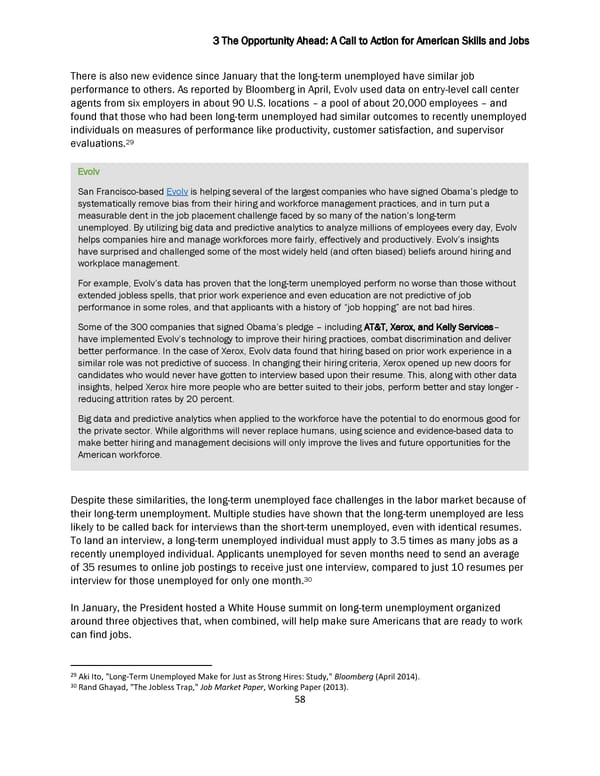3 The Opportunity Ahead: A Call to Action for American Skills and Jobs There is also new evidence since January that the long-term unemployed have similar job performance to others. As reported by Bloomberg in April, Evolv used data on entry-level call center agents from six employers in about 90 U.S. locations – a pool of about 20,000 employees – and found that those who had been long-term unemployed had similar outcomes to recently unemployed individuals on measures of performance like productivity, customer satisfaction, and supervisor 29 evaluations. Evolv San Francisco-based Evolv is helping several of the largest companies who have signed Obama’s pledge to systematically remove bias from their hiring and workforce management practices, and in turn put a measurable dent in the job placement challenge faced by so many of the nation’s long-term unemployed. By utilizing big data and predictive analytics to analyze millions of employees every day, Evolv helps companies hire and manage workforces more fairly, effectively and productively. Evolv’s insights have surprised and challenged some of the most widely held (and often biased) beliefs around hiring and workplace management. For example, Evolv’s data has proven that the long-term unemployed perform no worse than those without extended jobless spells, that prior work experience and even education are not predictive of job performance in some roles, and that applicants with a history of “job hopping” are not bad hires. Some of the 300 companies that signed Obama’s pledge – including AT&T, Xerox, and Kelly Services– have implemented Evolv’s technology to improve their hiring practices, combat discrimination and deliver better performance. In the case of Xerox, Evolv data found that hiring based on prior work experience in a similar role was not predictive of success. In changing their hiring criteria, Xerox opened up new doors for candidates who would never have gotten to interview based upon their resume. This, along with other data insights, helped Xerox hire more people who are better suited to their jobs, perform better and stay longer - reducing attrition rates by 20 percent. Big data and predictive analytics when applied to the workforce have the potential to do enormous good for the private sector. While algorithms will never replace humans, using science and evidence-based data to make better hiring and management decisions will only improve the lives and future opportunities for the American workforce. Despite these similarities, the long-term unemployed face challenges in the labor market because of their long-term unemployment. Multiple studies have shown that the long-term unemployed are less likely to be called back for interviews than the short-term unemployed, even with identical resumes. To land an interview, a long-term unemployed individual must apply to 3.5 times as many jobs as a recently unemployed individual. Applicants unemployed for seven months need to send an average of 35 resumes to online job postings to receive just one interview, compared to just 10 resumes per 30 interview for those unemployed for only one month. In January, the President hosted a White House summit on long-term unemployment organized around three objectives that, when combined, will help make sure Americans that are ready to work can find jobs. 29 Aki Ito, "Long-Term Unemployed Make for Just as Strong Hires: Study," Bloomberg (April 2014). 30 Rand Ghayad, "The Jobless Trap," Job Market Paper, Working Paper (2013). 58
 Biden Ready to Work White Paper 7/22/14 Page 57 Page 59
Biden Ready to Work White Paper 7/22/14 Page 57 Page 59